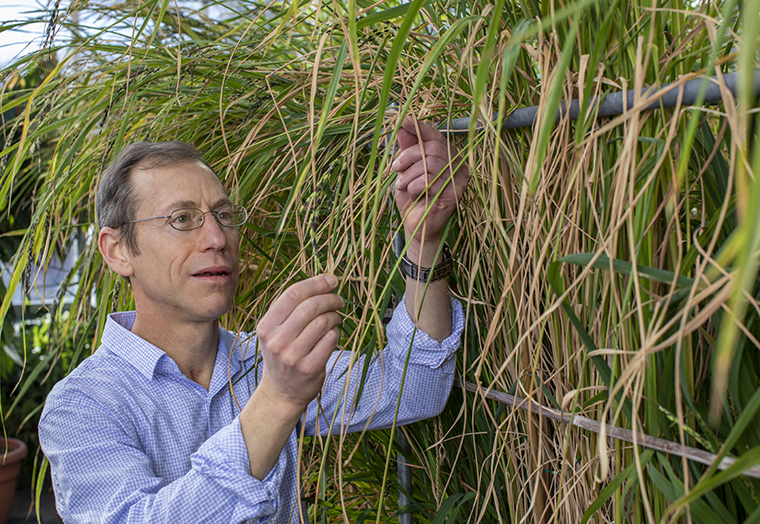By Talia Ogliore
March 7, 2024


Biologist Kenneth Olsen, in Arts & Sciences, joined researchers from 24 countries in an effort to strengthen cooperation and solve a key problem of improving rice yields. (Photo: Joe Angeles/Washington University)
Kenneth Olsen, a George William and Irene Koechig Freiberg Professor of Biology in Arts & Sciences at Washington University in St. Louis, joined researchers from 24 countries in establishing the Global Alliance for the Conservation of Wild Rice. The alliance also includes representatives from the Chinese Academy of Agricultural Sciences, Yazhou Bay National Laboratory and the International Rice Research Institute.
The group aims to promote innovative research on wild rice germplasm resources through strengthening international cooperation, respecting biodiversity and promoting resource sharing. On March 4, the researchers shared details about their mission and plans in the journal Molecular Plant.
Wild rice is a valuable germplasm resource, with genes that support disease resistance, insect resistance and stress resistance traits, Olsen and his colleagues noted.
These germplasm resources play a vital role in increasing rice yields, improving quality and enhancing adaptability. In the context of global climate change, frequent occurrence of agricultural pests and diseases and poor international scientific research and cooperation on wild rice, the global protection and utilization of wild rice germplasm resources is particularly important and urgent, the scientists said.
Olsen’s research focuses on the genetic basis of evolution in plants. One of his major research thrusts is the genomic basis of weedy rice competitiveness; in February 2024, Olsen and partners in China, Malaysia and Thailand published a study in Nature Communications about how porous borders at the wild-crop interface promote weed adaptation in Southeast Asia.
Kenneth Olsen, a George William and Irene Koechig Freiberg Professor of Biology in Arts & Sciences at Washington University in St. Louis, joined researchers from 24 countries in establishing the Global Alliance for the Conservation of Wild Rice. The alliance also includes representatives from the Chinese Academy of Agricultural Sciences, Yazhou Bay National Laboratory and the International Rice Research Institute.
The group aims to promote innovative research on wild rice germplasm resources through strengthening international cooperation, respecting biodiversity and promoting resource sharing. On March 4, the researchers shared details about their mission and plans in the journal Molecular Plant.
Wild rice is a valuable germplasm resource, with genes that support disease resistance, insect resistance and stress resistance traits, Olsen and his colleagues noted.
These germplasm resources play a vital role in increasing rice yields, improving quality and enhancing adaptability. In the context of global climate change, frequent occurrence of agricultural pests and diseases and poor international scientific research and cooperation on wild rice, the global protection and utilization of wild rice germplasm resources is particularly important and urgent, the scientists said.
Olsen’s research focuses on the genetic basis of evolution in plants. One of his major research thrusts is the genomic basis of weedy rice competitiveness; in February 2024, Olsen and partners in China, Malaysia and Thailand published a study in Nature Communications about how porous borders at the wild-crop interface promote weed adaptation in Southeast Asia.
No comments:
Post a Comment